
Welcome back to The Node Ahead, a cryptoasset resource for financial advisors.
Every other week, we discuss the latest crypto news and the potential impacts it may have on you and your clients.
In this edition, we will review:
- On-Chain Analysis
- The Responsible Financial Innovation Act
- BTC being used as a reserve asset
- In Other News
On-Chain Analysis
Since the start of the year, bitcoin has been range bound between $34k – $47k. We have examined this trend in detail in past newsletters, but the quick recap is that the average cost basis for those short-term holders who bought towards the end of last year when bitcoin was on its way to new all-time highs sits just under $47,000. Every time we approach this level the sell pressure increases from those market participants looking to get their initial investment back thus creating an upper bound resistance level. Sure enough, last week we touched $47k and once again we saw an increase in selling activity resulting in the price of bitcoin dropping back down into the mid $40,000s.
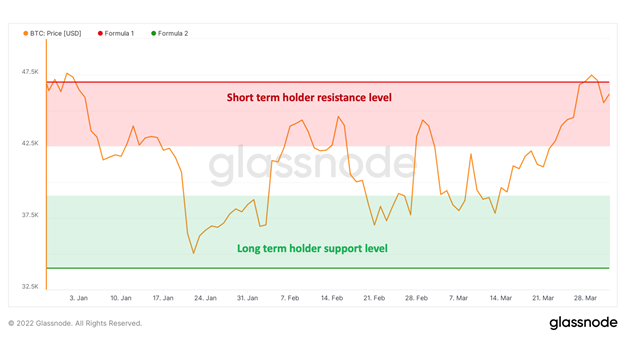
This trend of short-term market participants selling to long term holders over the last 3 months has created a supply squeeze that is arguably bigger than the one we saw towards the end of 2020 which pushed BTC to $60k for the first time. One way we can see this in the data is a metric created by Will Clemente and Willy Woo called the Illiquid Supply Shock ratio, which attempts to model the probability of a Supply Shock forming. The ratio compares the amount of Illiquid Supply to the sum of Liquid and Highly Liquid Supply in the market, thus giving us an indication of the coins available to be traded relative to the current demand. Below is a chart of this metric since the start of 2020.
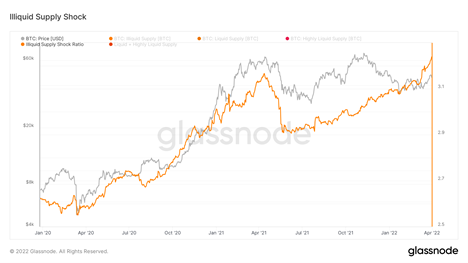
As we can see, the ratio is back above 3. This means that, for every bitcoin available to be traded, 3 are held away in cold storage not available to trade. That’s right – over 75% of bitcoin’s outstanding supply is locked away right now, and the percent is growing. As the proportion of illiquid supply of bitcoin continues to grow relative to the liquid supply available to be traded, the likelihood of a supply squeeze increases.
That’s the supply side, but what about the demand side of the equation? After bottoming out in the summer of last year, the number of active entities that were either a sender or receiver of bitcoin has steadily been increasing over the last several months. This is an important metric to keep an eye on as it gives us insight into how much demand there is to trade and use bitcoin. Active entities have historically increased substantially during large upward price movements. Should this trend continue, that would mean there would be increasing demand to buy and sell bitcoin at the same time the amount of available supply to do so is decreasing.
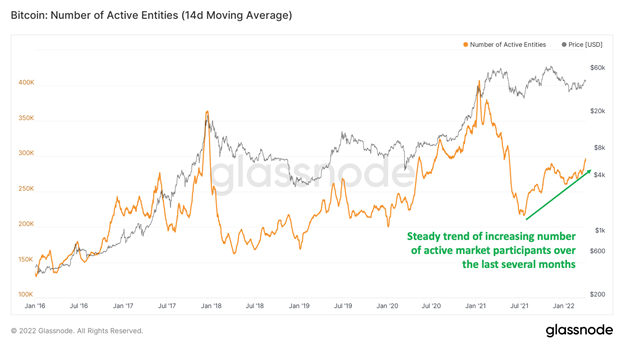
The main takeaway is that the stage is set for a sharp upward movement sometime this year. Bitcoin is coiling up like a spring and once the last marginal short-term seller has been exhausted, thus removing that upper bound resistance, bitcoin should have a clear path to new all-time highs. Predicting exactly when that will happen…well, your guess is as good as ours.
Lummis’ Crypto Bill Update
Last newsletter we covered The Responsible Financial Innovation Act drafted by Wyoming Senator Cynthia Lummis and explained why it could be the most comprehensive piece of crypto legislation to date. Since then, the bill’s bi-partisan support increased when Democratic Senator Kirsten Gillibrand officially joined as a co-sponsor of the bill – but Senator Lummis wasn’t done yet. Though the bill is nearly complete, it appears Lummis’s office is currently also seeking edits from Pat Toomey before officially submitting the bill. Not only is Toomey a crypto advocate but also the ranking member of the Senate Banking Committee for the Republican party. Should the Democrats lose the Senate majority in the next election, Pat Toomey would become the chairman of the Senate Banking Committee. Thus, a Toomey-approved proposal, even with a slim Republican majority, would likely have enough Democratic votes in the Senate to pass.
Using BTC to Stabilize Stablecoins
The growth and usage of stablecoins has exploded over the past couple of years. At the start of 2020, the total stablecoin market was $6 billion. Just over two years later, there are now more than $180 billion worth of stablecoins in the market. There is no denying that stablecoins have found a clear product-market fit. Ironically, the most popular stablecoins in the market today are very centralized; that is, until recently.
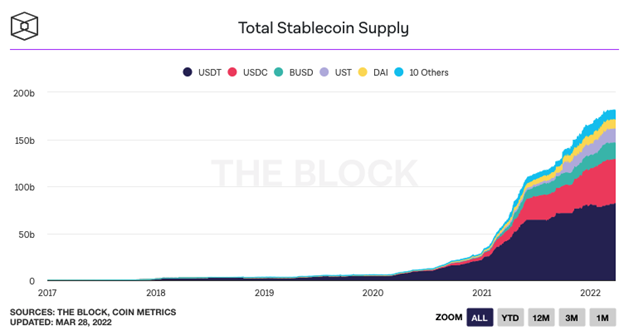
Before we jump into how the stablecoin market is evolving, we need to first understand what stablecoins are and why they exist. Cryptoassets have several benefits, most notably they enable the transfer of value without the need for third party intermediaries, but they also experience a lot of volatility. These rapid price swings make it difficult to rely on them over short time frames and as a medium of exchange. As a result, stablecoins were created to maintain a constant price (hence the name).
Stablecoins have several of the same advantages of other cryptoassets such as being open, global, and accessible to anyone on the internet without the need for a bank account. Stablecoins can be used as a liquid placeholder while investors wait for more attractive investment opportunities. Consumers can hold stablecoins and earn a much higher yield compared to traditional savings accounts. Fast processing and low transaction fees make stablecoins a good choice for sending money across borders without having to pay exchange fees. Stablecoins also offer the ability for merchants to accept payments without paying the 3% fee that credit card companies charge on every transaction.
Stablecoins maintain their prices using one of two methods. The first, and by far the most popular method today, is by collateralizing the stablecoin with another asset. The three largest stablecoins today (USDT, USDC, and BUSD) are all backed by the United States dollar. Dollars or US Treasuries are deposited into a bank, after which a stablecoin is issued with a 1:1 ratio against those dollars. When a person wants to convert their stablecoin back to USD, that stablecoin is destroyed and USD is issued to that user.
It is also possible to back a stablecoin with something other than fiat currency. Asset collateralized stablecoins function the same way fiat collateralized stablecoins do, except the underlying reserve asset is a commodity rather than a fiat currency. The most common underlying asset is gold and other precious metals. Though asset collateralized stablecoins are much smaller than fiat backed stablecoins, one of the largest asset collateralized stablecoins in the market today is Paxos. Each PAXG token is redeemable for 1 troy ounce of gold held in custody by Paxos and its partners.
The biggest drawback of the asset backed model is the resulting centralization of these stablecoins. An asset backed stablecoin requires a central entity to custody the underlying asset and facilitate the issuance of the stablecoin. For example, USDC, the largest stablecoin on the market today, is controlled and issued by Circle. USDT (the second largest) is controlled by Bitfinex and BUSD (the third largest) is controlled by Binance. Furthermore, these stablecoins require its users to trust that the central authority actually has the proper amount of underlying collateral it claims it does. These concentrated risks have already manifested into legal trouble for USDT and USDC which have both had a history of regulatory run ins.
Another potential risk with centrally controlled stablecoins is regulation. There is increasing scrutiny on the use of stablecoins and desire to bring stablecoins within the existing banking system. As long as a central entity controls the stablecoin, it is subject to political whims, government seizure, and assets being frozen. Hence, centralized stablecoins negate much of the benefits of self-sovereignty and censorship resistance that decentralization is supposed to provide.
Which brings us to the second method for maintaining price stability. Algorithmic stablecoins maintain their price peg through a set of self-executing rules rather than relying on collateralization. Thus, algorithmic based stablecoins do not require a centralized authority to operate; they are completely decentralized. Algorithmic based stablecoins align much better with the mission and ethos of bitcoin, DeFi and crypto at large.
The largest algorithmic based stablecoin on the market today is TerraUSD, otherwise known as UST. UST was the fastest growing stablecoin in 2021. In less than 18 months UST has become the largest decentralized stablecoin and fourth largest stablecoin overall by market cap.
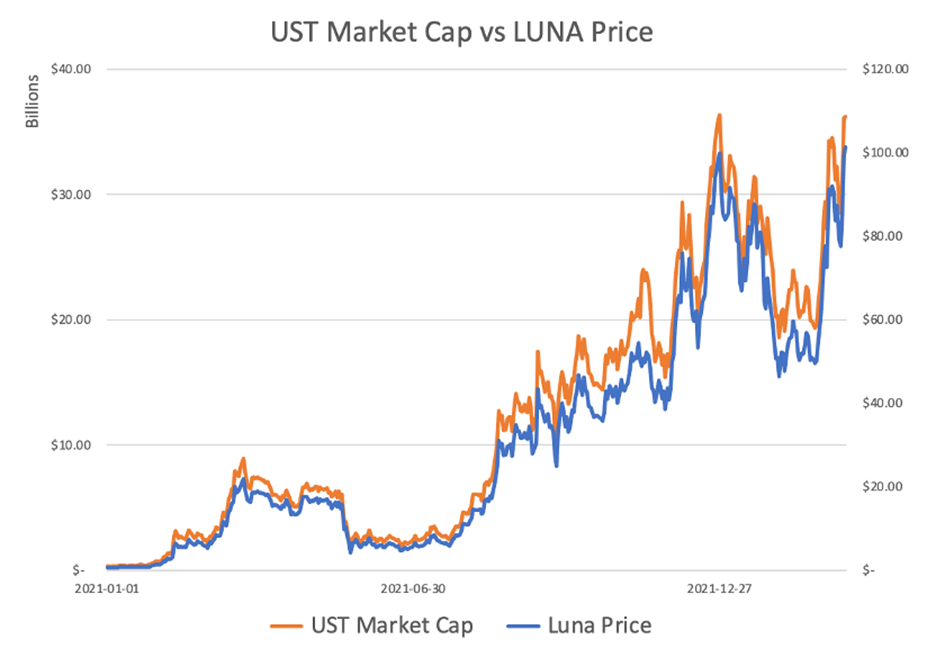
Before we jump into how the stablecoin market is evolving, we need to first understand what stablecoins are and why they exist. Cryptoassets have several benefits, most notably they enable the transfer of value without the need for third party intermediaries, but they also experience a lot of volatility. These rapid price swings make it difficult to rely on them over short time frames and as a medium of exchange. As a result, stablecoins were created to maintain a constant price (hence the name).
Stablecoins have several of the same advantages of other cryptoassets such as being open, global, and accessible to anyone on the internet without the need for a bank account. Stablecoins can be used as a liquid placeholder while investors wait for more attractive investment opportunities. Consumers can hold stablecoins and earn a much higher yield compared to traditional savings accounts. Fast processing and low transaction fees make stablecoins a good choice for sending money across borders without having to pay exchange fees. Stablecoins also offer the ability for merchants to accept payments without paying the 3% fee that credit card companies charge on every transaction.
Stablecoins maintain their prices using one of two methods. The first, and by far the most popular method today, is by collateralizing the stablecoin with another asset. The three largest stablecoins today (USDT, USDC, and BUSD) are all backed by the United States dollar. Dollars or US Treasuries are deposited into a bank, after which a stablecoin is issued with a 1:1 ratio against those dollars. When a person wants to convert their stablecoin back to USD, that stablecoin is destroyed and USD is issued to that user.
It is also possible to back a stablecoin with something other than fiat currency. Asset collateralized stablecoins function the same way fiat collateralized stablecoins do, except the underlying reserve asset is a commodity rather than a fiat currency. The most common underlying asset is gold and other precious metals. Though asset collateralized stablecoins are much smaller than fiat backed stablecoins, one of the largest asset collateralized stablecoins in the market today is Paxos. Each PAXG token is redeemable for 1 troy ounce of gold held in custody by Paxos and its partners.
The biggest drawback of the asset backed model is the resulting centralization of these stablecoins. An asset backed stablecoin requires a central entity to custody the underlying asset and facilitate the issuance of the stablecoin. For example, USDC, the largest stablecoin on the market today, is controlled and issued by Circle. USDT (the second largest) is controlled by Bitfinex and BUSD (the third largest) is controlled by Binance. Furthermore, these stablecoins require its users to trust that the central authority actually has the proper amount of underlying collateral it claims it does. These concentrated risks have already manifested into legal trouble for USDT and USDC which have both had a history of regulatory run ins.
Another potential risk with centrally controlled stablecoins is regulation. There is increasing scrutiny on the use of stablecoins and desire to bring stablecoins within the existing banking system. As long as a central entity controls the stablecoin, it is subject to political whims, government seizure, and assets being frozen. Hence, centralized stablecoins negate much of the benefits of self-sovereignty and censorship resistance that decentralization is supposed to provide.
Which brings us to the second method for maintaining price stability. Algorithmic stablecoins maintain their price peg through a set of self-executing rules rather than relying on collateralization. Thus, algorithmic based stablecoins do not require a centralized authority to operate; they are completely decentralized. Algorithmic based stablecoins align much better with the mission and ethos of bitcoin, DeFi and crypto at large.
The largest algorithmic based stablecoin on the market today is TerraUSD, otherwise known as UST. UST was the fastest growing stablecoin in 2021. In less than 18 months UST has become the largest decentralized stablecoin and fourth largest stablecoin overall by market cap.
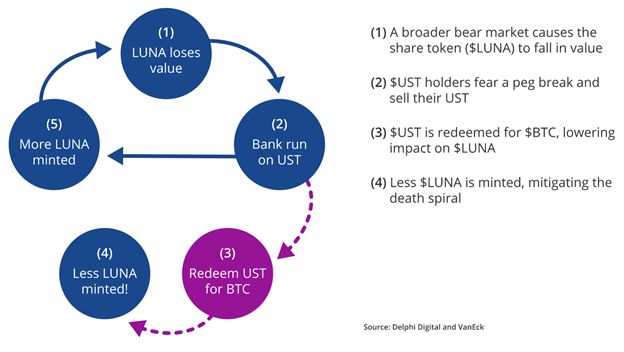
By giving UST holders the right to redeem $1 worth of Bitcoin rather than minting new LUNA, it is possible that Terra has found an end to the “death spiral” problem. Bitcoin is fully decentralized, fully transparent and has a predictable monetary policy which makes it a superior form of collateral. By using bitcoin as a reserve asset, Terra maintains all the benefits of decentralization that centralized stablecoins backed by fiat dollars can’t provide. There is no need to trust a centralized third party that all the collateral is truly there. Nor would we need to rely on an accounting firm to audit those reserves; we will be able to see it all for ourselves on the blockchain!
It also means Terra is becoming a persistent buyer of bitcoin. Thus far, Terra has already bought over $1.5 billion worth of bitcoin in recent weeks and by all accounts, seems to be on pace for approximately $135 million in daily buying. To put that in perspective, Terra is purchasing approximately 300% of the new daily supply issuance of bitcoin.
Terra buying $10 billion worth of bitcoin is no different than Tesla, MicroStrategy, and El Salvador buying it and holding it as a reserve asset. It isn’t much of a leap to envision a world where fiat currencies or Central Bank Digital Currencies (CBDCs) are backed by bitcoin as well. This would be a replication of the gold standard but using digital gold instead of the analog version. In the not-too-distant future, it’s likely we will even see central banks do what Terra is doing. Bitcoin is slowly becoming the new world reserve currency for both the fiat world and the crypto universe.
Why this matters for RIAs – Stablecoins are becoming an increasingly important part of the financial system. Understanding the tradeoffs between various stablecoins is critical to understanding the benefits and risks associated with using them.
In Other News
A new Goldman Sachs survey shows 60% of surveyed clients expect to increase their crypto holdings this year. 51% of its clients reported exposure to digital assets, up from 40% last year.
According to an NBC News poll, one in five Americans has invested in, traded or otherwise used cryptoassets and 50% of men between the ages of 18 and 49 say they’ve at least dabbled in crypto.
Recent studies show that bitcoin ownership has tripled in the last 3 years, while ownership of stocks and gold have remained stagnant.
Ray Dalio’s Bridgewater, the world’s largest hedge fund, is creating a dedicated crypto fund.
Goldman Sachs believes that crypto is a megatrend that will reshape economies.
Blackrock, with over $10T in assets, is preparing to enter the blockchain technology, cryptocurrency and digital asset space in a massive way.
BlackRock CEO Larry Fink believes that crypto based global payment system can enhance the settlement of international transactions, reduced the risk of money laundering and corruption, lower the cost of cross border payments and the war in Ukraine could expedite digital currency adoption.
Senator Ted Cruz introduced a bill to prevent the Fed from issuing a CBDC. Few days later, Elizabeth Warren said the US should create a CBDC.
A new proposal by the SEC is aiming to redefine what it means to be a securities dealer. The expanded definition would include people and businesses that use automated and algorithmic trading technology to execute trades and provide liquidity in the market which may have implications for digital assets and DeFi.
Sen. Elizabeth Warren has introduced legislation meant to limit Russia’s capacity to avoid sanctions using crypto. The bill has drawn backlash over its broad language, which could encompass uninvolved entities.
The Malaysian legislature is proposing the making bitcoin and other cryptocurrencies legal tender.
Ukrainian refugee flees to Poland with 40% of her life savings on a USB drive.
Russia may start selling its oil and gas for bitcoin.
The largest U.S. oil and gas company, Exxon Mobil, is using excess natural gas to mine bitcoin and is considering expanding to four more countries.
Governor Ron DeSantis announced that the state of Florida is working on a plan to accept bitcoin and other cryptocurrencies for business taxes.
US fintech firm Figure opened the waiting list for its forthcoming crypto-backed mortgage service.
Disclaimer: This is not investment advice. This content is for informational purposes only, you should not construe any such information or other material as legal, tax, investment, financial, or other advice. Nothing contained constitutes a solicitation, recommendation, endorsement, or offer to buy or sell any securities or other financial instruments in this or in any other jurisdiction in which such solicitation or offer would be unlawful under the securities laws of such jurisdiction. All Content is information of a general nature and does not address the circumstances of any particular individual or entity. Opinions expressed are solely my own and do not express the views or opinions of Blockforce Capital or Onramp Invest.
